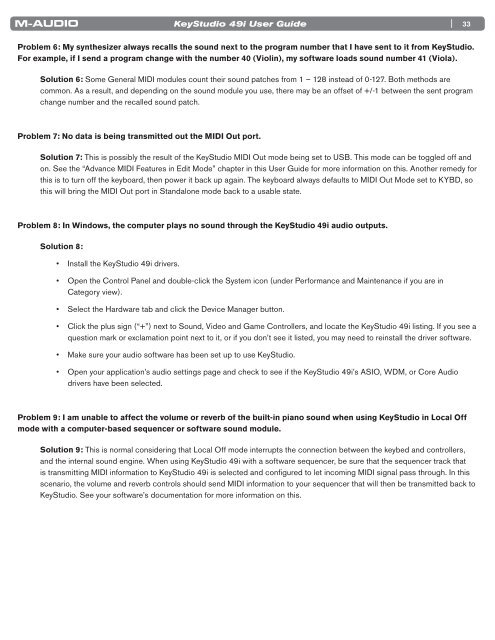User Guide | KeyStudio 49i - M-Audio
User Guide | KeyStudio 49i - M-Audio
User Guide | KeyStudio 49i - M-Audio
Create successful ePaper yourself
Turn your PDF publications into a flip-book with our unique Google optimized e-Paper software.
<strong>KeyStudio</strong> <strong>49i</strong> <strong>User</strong> <strong>Guide</strong><br />
| 33<br />
Problem 6: My synthesizer always recalls the sound next to the program number that I have sent to it from <strong>KeyStudio</strong>.<br />
For example, if I send a program change with the number 40 (Violin), my software loads sound number 41 (Viola).<br />
Solution 6: Some General MIDI modules count their sound patches from 1 – 128 instead of 0-127 Both methods are<br />
common As a result, and depending on the sound module you use, there may be an offset of +/-1 between the sent program<br />
change number and the recalled sound patch<br />
Problem 7: No data is being transmitted out the MIDI Out port.<br />
Solution 7: This is possibly the result of the <strong>KeyStudio</strong> MIDI Out mode being set to USB This mode can be toggled off and<br />
on See the “Advance MIDI Features in Edit Mode” chapter in this <strong>User</strong> <strong>Guide</strong> for more information on this Another remedy for<br />
this is to turn off the keyboard, then power it back up again The keyboard always defaults to MIDI Out Mode set to KYBD, so<br />
this will bring the MIDI Out port in Standalone mode back to a usable state<br />
Problem 8: In Windows, the computer plays no sound through the <strong>KeyStudio</strong> <strong>49i</strong> audio outputs.<br />
Solution 8:<br />
• Install the <strong>KeyStudio</strong> <strong>49i</strong> drivers.<br />
• Open the Control Panel and double-click the System icon (under Performance and Maintenance if you are in<br />
Category view)<br />
• Select the Hardware tab and click the Device Manager button.<br />
• Click the plus sign (“+”) next to Sound, Video and Game Controllers, and locate the <strong>KeyStudio</strong> <strong>49i</strong> listing. If you see a<br />
question mark or exclamation point next to it, or if you don’t see it listed, you may need to reinstall the driver software<br />
• Make sure your audio software has been set up to use <strong>KeyStudio</strong>.<br />
• Open your application’s audio settings page and check to see if the <strong>KeyStudio</strong> <strong>49i</strong>’s ASIO, WDM, or Core <strong>Audio</strong><br />
drivers have been selected<br />
Problem 9: I am unable to affect the volume or reverb of the built-in piano sound when using <strong>KeyStudio</strong> in Local Off<br />
mode with a computer-based sequencer or software sound module.<br />
Solution 9: This is normal considering that Local Off mode interrupts the connection between the keybed and controllers,<br />
and the internal sound engine When using <strong>KeyStudio</strong> <strong>49i</strong> with a software sequencer, be sure that the sequencer track that<br />
is transmitting MIDI information to <strong>KeyStudio</strong> <strong>49i</strong> is selected and configured to let incoming MIDI signal pass through In this<br />
scenario, the volume and reverb controls should send MIDI information to your sequencer that will then be transmitted back to<br />
<strong>KeyStudio</strong> See your software’s documentation for more information on this

















